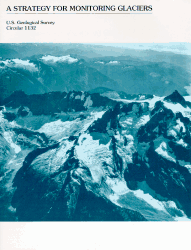|

Top of this page
|
|
 A Strategy for Monitoring Glaciers A Strategy for Monitoring Glaciers
By Andrew G. Fountain, Robert M. Krimmel, and Dennis C. Trabant
U.S. GEOLOGICAL SURVEY
Circular 1132
ABSTRACT
Glaciers are important features in the hydrologic cycle and affect the volume,
variability, and water quality of runoff. Assessing and predicting the effect of glaciers
on water resources require a monitoring program to provide basic data for this
understanding. The monitoring program of the U.S. Geological Survey employs a nested
approach whereby an intensively studied glacier is surrounded by less intensively studied
glaciers and those monitored solely by remote sensing. Ideally, each glacierized region of
the United States would have such a network of glaciers. The intensively studied glacier
provides a detailed understanding of the physical processes and their temporal changes
that control the mass exchange of the glaciers in that region. The less intensively
studied glaciers are used to assess the variability of such processes within the region.
Fountain, A.G., Krimmel, R.M., and Trabant, D.C., 1997, A strategy for monitoring
glaciers: U.S. Geological Survey Circular 1132, 19 p.
 [Full Report, Acrobat PDF v.3 (1054 KB)]
[Full Report, Acrobat PDF v.3 (1054 KB)]
 Adobe Acrobat's .pdf (portable document file) format can be viewed using the free Adobe Acrobat Reader
available for DOS, Windows, Macintosh, and UNIX. This link will allow you to get the free
download and installation instructions from Adobe. Adobe Acrobat's .pdf (portable document file) format can be viewed using the free Adobe Acrobat Reader
available for DOS, Windows, Macintosh, and UNIX. This link will allow you to get the free
download and installation instructions from Adobe.
Maintainer: Rod March
Last update: Thursday, January 15, 2004 04:44 PM
URL: http://ak.water.usgs.gov/glaciology/reports/Circular1132.htm
|
